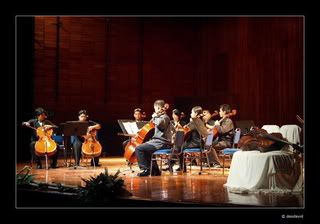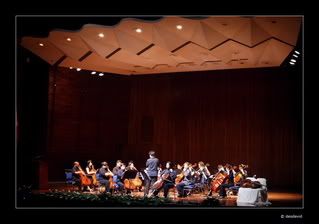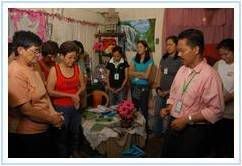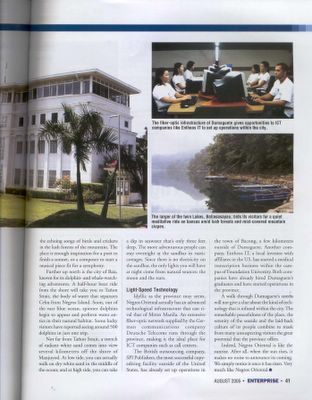by Vanessa VelascoPhotos by Deo David(published in the October 2005 issue of Enterprise Magazine)
 The two-century old cello, formerly owned by cellist Vicente “Tiking” Lopez Jr., quietly rests on the right side of the stage during the “Bach to Metallica” concert at the PhilamLife Theatre.
The two-century old cello, formerly owned by cellist Vicente “Tiking” Lopez Jr., quietly rests on the right side of the stage during the “Bach to Metallica” concert at the PhilamLife Theatre.The 200-year-old cello, prominently propped up on two chairs on the stage of PhilamLife Theatre, gave a prelude to what was in store for the audience. Then, as the hall lights began to dim, the old cello became more resplendent. One by one the cellists came, and took the audience through a sweeping musical journey from the Baroque period of the late 1600s to the high romantics of the 19
th century. It is a fitting occasion, ancient and new cellos making music in this concert organized in honor of the late Vicente Lopez Jr., the former owner of the two-century old cello.
At program’s end, music shifted to 21
st century heavy metal – except that eighteen cellos were playing in lieu of electric guitars – resulting in a finer and gentler sound. “Bach to Metallica
”: that’s a fitting name for the concert, as eighteen Filipino cellists gave the audience a taste of music that spanned several musical eras. When the music ceased, the crowd who were silent all throughout the program burst into a jubilant applause.
 One of the country’s premier cellists, Renato Lucas, opens the program with a prelude by Johann Sebastian Bach. After the Performance
One of the country’s premier cellists, Renato Lucas, opens the program with a prelude by Johann Sebastian Bach. After the PerformanceIn one fleeting moment, these artists revel in the admiration of the crowd. But once the applause dies down and the stage lights dim, they return to the reality many classical musicians face: the struggle to make a living. Classical music artists receive very little recognition – and compensation – compared to pop artists. In reality, many classical musicians receive only around 10% of what their pop counterparts actually earn.
Similarly, cultural organizations are experiencing difficulties. Among the country’s orchestras, only the Philippine Philharmonic Orchestra has a regular season this year. Other orchestras have virtually stopped staging their own concerts – some even started to accept bookings for non-cultural events such as weddings and debuts just to make both ends meet. Many classical artists have even gone overseas to seek greener pastures: to countries where their music is more appreciated, and they themselves are better compensated.“Classical artists are not faring well in the country because there is not much media exposure for their music,” says Martin Lopez, executive director of
Sinagtala, the foundation that staged “Bach to Metallica”. “We only have a few venues where we can promote classical music. There's DZFE, the only classical radio station in the country. And yet, even DZFE is not spared from financial crisis and in fact has reduced its broadcast hours due to budget constraints. This effectively reduced the exposure for classical music.”
Diminishing AudienceTiffany Joy Liong, DZFE’s station manager, says that the station's reduced broadcast hours may have indeed affected the reach of classical music. She explains: “It is through DZFE that many people hone their appreciation for the classics and the reduction of broadcast hours by 40% may have diminished our reach, and may have resulted in losing some listeners.”
But the few listeners who remain are a captive audience. These are the discriminating crowd – those who have an ear for fine music, and who can discern what is good and what is not. That explains the applause of the crowd in the concert hall of the PhilamLife Theatre. The applause was not that of the uninitiated, but the educated taste – classical enthusiasts who know the fine distinction between a good and a so-so performance. And classical pieces are not the monopoly of grown-ups.
Pianist J. Greg Zuniega recounts how the students in his music appreciation programs would respond to classical music. “You only need to educate people what the music is all about,” he says. “Once they have a grasp and an understanding of the music, they keep asking for more.”
One Step At A TimeThese artists, committed to uphold the legacy of classical music, will not stop until they have shared such fine and beautiful heritage. Martin, noting that the effort is long and arduous, summed up in one sentence how artists will propagate classical music: “We will get there, one step at a time.”
 Eight cellists from various orchestras in the country perform a work by Brazilian composer Heitor Villalobos.One artist at a time. Sinagtala
Eight cellists from various orchestras in the country perform a work by Brazilian composer Heitor Villalobos.One artist at a time. Sinagtala supports the classical artists by helping them find bookings abroad. "There are opportunities outside the country where the artists can gain recognition, and at the same time, have higher compensation," says Martin, "our purpose is for them to perform outside of the country, but they must be back in their native soil; their base should still be here in the Philippines." This has somehow helped our artists cope with financial difficulties without having to reside abroad.
One barrio at a time. World-class violinist Gilopez Kabayao and his wife, pianist Corazon Pineda-Kabayao, have traveled from barrio to barrio – from small schoolhouses to barangay streets to cockpits – to perform and organize simple classes on music appreciation. They have been conducting these classes for years – free of charge, with travel expenses paid out of their own pocket.
One school at a time. Concert pianist J.Greg Zuniega takes with him other artists from one school to another to hone student appreciation for Filipino music and culture. He calls this “audience development,” where he gives free performances to non-classical music listeners and then educates them about the music’s history, plus its significance to our culture. “They actually like the music – and even requested us to come back and perform for them,” Greg says. “It is just a matter introducing them to ‘something finer’.”
One instrument at a time. Concert flutist Ray Sison, for his part, sources out instruments from abroad and deals with manufacturers directly, then makes them available to orchestras. "Good musicians will still sound good even on student model instruments," he points out, "But, of course, they will sound much better with better instruments."
 An ensemble of the Philippines' best cellists in their rendition of Metallica's "Fade to Black" composed by James Hetfield and Lars Ulrich; and arrange for eighteen cellos by Alvin Castillo.Corporations Support the Arts
An ensemble of the Philippines' best cellists in their rendition of Metallica's "Fade to Black" composed by James Hetfield and Lars Ulrich; and arrange for eighteen cellos by Alvin Castillo.Corporations Support the ArtsMoney-making corporations support classical music through their own foundations, or they include sponsorships for concerts and art exhibits in their yearly budget. Interestingly, the business sector has come up with ways other than cash sponsorships to help propagate the legacy of culture and the arts.
For instance, San Miguel Corporation has established its own orchestra and choral group – the San Miguel Philharmonic Orchestra and the San Miguel Master Chorale. The initial reaction of the other orchestras and choral groups was one of disapproval when several of their members have left the group to join San Miguel. However, this move is generally seen as a development in the classical scene since San Miguel has given musicians and vocalists a chance to earn a little more.
Some of Manila’s better concert halls are owned by corporations, which they have built in their own head offices. Somehow, their support for the foundations dedicated to classical music takes the form of their allowing concerts staged in their halls free of charge. Thus, through this kind of sponsorship, we get to enjoy fine performances at the PhilAmLife Theatre, at the Equitable PCI Bank’s Francisco Santiago Hall, the Meralco Theatre and RCBC’s Carlos P. Romulo Auditorium.
Company sponsorships may also take the form of supporting individual performers. Wyeth champions promising young musicians through their Gifted Child campaign. Aside from giving these kids publicity through television commercials and events, Wyeth also sponsors concerts that feature their roster of gifted children.
Other corporations – like the Ayala Corporation, Petron, Metrobank, and Toyota, among others – have established their reputation as staunch patrons of the arts. For years, they have partnered with cultural organizations and enabled them to continue propagating classical music.
In a manner of speaking, foundations are the driving force in the development of classical music; the corporations constitute the enabling force that allows these foundations to play their role well. This partnership between businesses and non-profits keeps the classical music scene moving forward, albeit slowly.

Eleven-year-old Pocholo Ramirez gives his rendition of a sonata by Benedetto Marcello, accompanied by pianist Harold Galang, Dean of the PWU Conservatory of Music.A Timeless LegacyAfter the concert at PhilamLife Theatre, several kids – all scholars of the Manila Philharmonic Orchestra Foundation – went onto the stage, each with a lei of flowers. All of them were violin students, and two have been identified as potential cellists.
With quick small steps, they walked up to the performers, who then gamely bowed so the kids can place the leis around their neck. The children’s eyes sparkled, before the older cellists who stood towering over them. The thought is inescapable: Someday these kids will be performing on that same stage – and the devotees of classical music shall have come full circle.
As the artists made their exit and the audience started to leave, there on stage, still quietly resting on two chairs was the old cello. And like the old cello, classical music is, too, supported by two sectors – the businesses and the foundations. Take away one of the chairs and the cello will fall. The same thing will happen to classical music if either the businesses or the foundations would cease to play their part in upholding our classical heritage.
And the compelling reason why they should not stop: "Classical music reminds us of our ideals,” says Tiffany, “telling us that there is something better, something more excellent than what a passing era or what society in general dictates.”
Martin articulates what these ideals are: “It is upholding our sense of culture. Classical musicians don’t go around promoting empty songs like otso-otso. We promote something more meaningful: the culture and harmony that can be found in classical music.”
Just a look at the young scholars should be enough motivation to propagate the legacy of classical music. They represent the next generation of those who will help shape the culture of this country. Let it be then a culture that our artists are working hard to preserve – one that is marked by harmony and excellence.
 After the program, the young scholars of the Manila Philharmonic Orchestra Foundation come up on stage to present leis to the performers.
After the program, the young scholars of the Manila Philharmonic Orchestra Foundation come up on stage to present leis to the performers.































